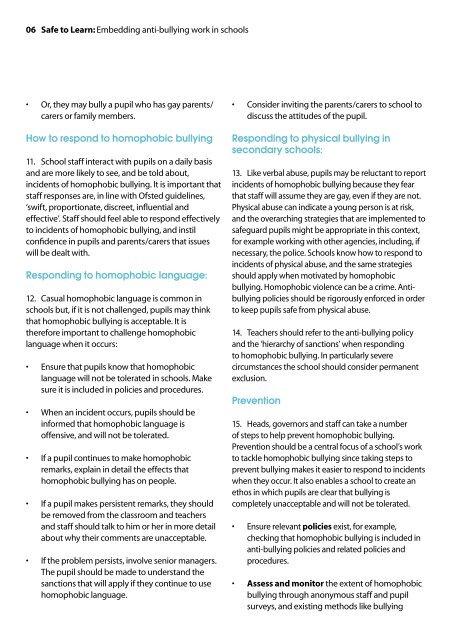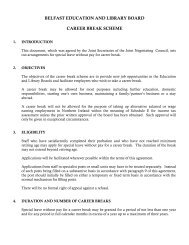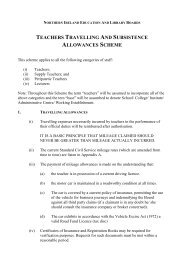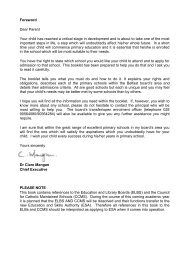Homophobic bullying - EACH
Homophobic bullying - EACH
Homophobic bullying - EACH
- No tags were found...
Create successful ePaper yourself
Turn your PDF publications into a flip-book with our unique Google optimized e-Paper software.
06 Safe to Learn: Embedding anti-<strong>bullying</strong> work in schools• Or, they may bully a pupil who has gay parents/carers or family members.How to respond to homophobic <strong>bullying</strong>11. School staff interact with pupils on a daily basisand are more likely to see, and be told about,incidents of homophobic <strong>bullying</strong>. It is important thatstaff responses are, in line with Ofsted guidelines,‘swift, proportionate, discreet, influential andeffective’. Staff should feel able to respond effectivelyto incidents of homophobic <strong>bullying</strong>, and instilconfidence in pupils and parents/carers that issueswill be dealt with.Responding to homophobic language:12. Casual homophobic language is common inschools but, if it is not challenged, pupils may thinkthat homophobic <strong>bullying</strong> is acceptable. It istherefore important to challenge homophobiclanguage when it occurs:• Ensure that pupils know that homophobiclanguage will not be tolerated in schools. Makesure it is included in policies and procedures.• When an incident occurs, pupils should beinformed that homophobic language isoffensive, and will not be tolerated.• If a pupil continues to make homophobicremarks, explain in detail the effects thathomophobic <strong>bullying</strong> has on people.• If a pupil makes persistent remarks, they shouldbe removed from the classroom and teachersand staff should talk to him or her in more detailabout why their comments are unacceptable.• If the problem persists, involve senior managers.The pupil should be made to understand thesanctions that will apply if they continue to usehomophobic language.• Consider inviting the parents/carers to school todiscuss the attitudes of the pupil.Responding to physical <strong>bullying</strong> insecondary schools:13. Like verbal abuse, pupils may be reluctant to reportincidents of homophobic <strong>bullying</strong> because they fearthat staff will assume they are gay, even if they are not.Physical abuse can indicate a young person is at risk,and the overarching strategies that are implemented tosafeguard pupils might be appropriate in this context,for example working with other agencies, including, ifnecessary, the police. Schools know how to respond toincidents of physical abuse, and the same strategiesshould apply when motivated by homophobic<strong>bullying</strong>. <strong>Homophobic</strong> violence can be a crime. Anti<strong>bullying</strong>policies should be rigorously enforced in orderto keep pupils safe from physical abuse.14. Teachers should refer to the anti-<strong>bullying</strong> policyand the ‘hierarchy of sanctions’ when respondingto homophobic <strong>bullying</strong>. In particularly severecircumstances the school should consider permanentexclusion.Prevention15. Heads, governors and staff can take a numberof steps to help prevent homophobic <strong>bullying</strong>.Prevention should be a central focus of a school’s workto tackle homophobic <strong>bullying</strong> since taking steps toprevent <strong>bullying</strong> makes it easier to respond to incidentswhen they occur. It also enables a school to create anethos in which pupils are clear that <strong>bullying</strong> iscompletely unacceptable and will not be tolerated.• Ensure relevant policies exist, for example,checking that homophobic <strong>bullying</strong> is included inanti-<strong>bullying</strong> policies and related policies andprocedures.• Assess and monitor the extent of homophobic<strong>bullying</strong> through anonymous staff and pupilsurveys, and existing methods like <strong>bullying</strong>
















